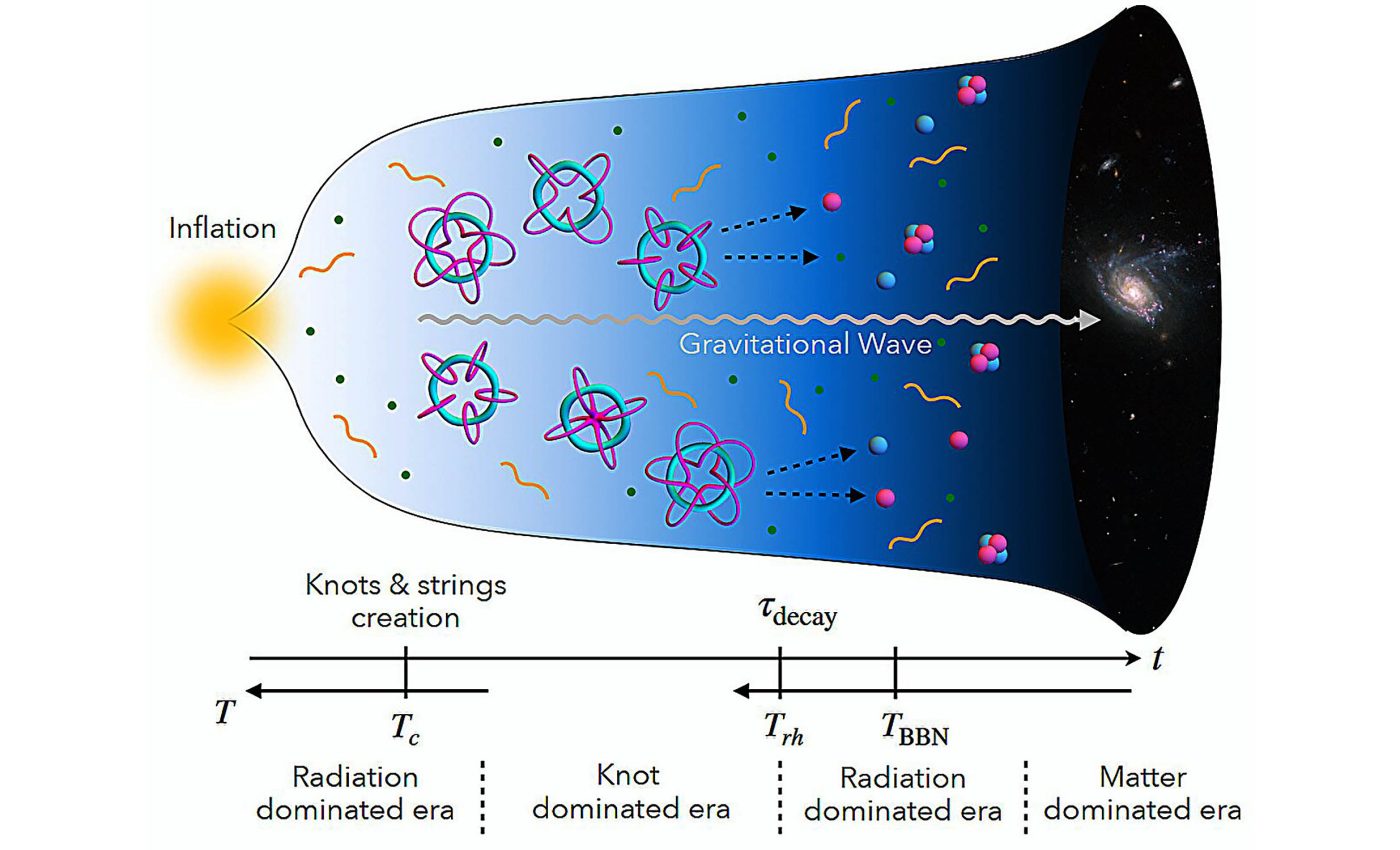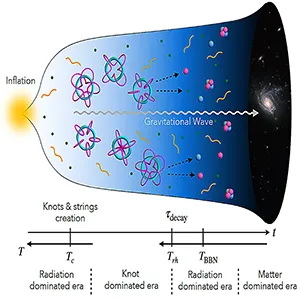
'Cosmic knots' may explain why the universe exists
A new idea revives a 19th-century vision with a modern twist: unusual cosmic “knots” in the newborn universe may have helped nudge reality toward matter, not antimatter.
In this picture, tangled loops of fields formed just after the Big Bang. After briefly dominating, they then collapsed in ways that left a tiny surplus of matter – the seed for everything from stars to people.
The research, published in the journal Physical Review Letters, comes from a team in Japan that builds a realistic particle- physics framework where such knots arise naturally.
The model doesn’t just aim at the matter-antimatter puzzle. It also folds in neutrino masses, dark matter, and the strong CP problem, tying several of physics’ loose threads into one approach.
Cosmic knots from past to present
In 1867, Lord Kelvin imagined atoms as knots in an all-pervading ether. The ether vanished from physics, and atoms turned out to be something else entirely. But the intuition – that topology can stabilize structures – never quite died.
The new work updates that old idea for the early universe. It replaces aether with well-motivated symmetries and fields that many physicists already consider promising extensions of the Standard Model.
“This study addresses one of the most fundamental mysteries in physics: why our universe is made of matter and not antimatter,” said study corresponding author Muneto Nitta, a professor at Hiroshima University.
“This question is important because it touches directly on why stars, galaxies, and we ourselves exist at all.”
Two forces, one explanation
At the heart of the framework are two familiar ideas: a gauged Baryon-Number-minus-Lepton-Number (B–L) symmetry and the Peccei–Quinn (PQ) symmetry.
PQ dynamics address the strong-CP problem and naturally introduce the axion, a prime dark matter candidate. B–L dynamics help explain why neutrinos have mass, via heavy right-handed neutrinos that many baryogenesis scenarios already rely on.
The recipe matters. Keeping PQ as a global (not gauged) symmetry preserves the delicate axion physics. Gauging B–L, by contrast, introduces a new force carrier and ensures the theory’s mathematical consistency.
It also gives rise to “superconducting” behavior in the B–L field that can trap magnetic-like flux. That magnetic backbone is essential for building cosmic knots that don’t instantly unravel.
Building cosmic knots from fields
In the hot, rapidly cooling early universe, symmetries broke like water freezing into ice, often leaving behind defects – cosmic strings – where different domains met.
The team shows that B–L breaking produces flux-carrying strings (think: narrow tubes with trapped field lines), while PQ breaking yields flux-free, superfluid-like vortices. On their own, either structure tends to shrink or snap, but together they can interlock.
Here’s the trick: the PQ vortex couples to the B-L flux tube through a Chern-Simons-type interaction. That coupling lets the PQ vortex pump charge into the B–L tube, adding a stabilizing current that counters the tube’s tension.
The interlinked loop becomes a metastable “knot soliton” – a topological configuration that can persist long enough to matter cosmologically before it decays.
“Nobody had studied these two symmetries at the same time,” Nitta said. “That was kind of lucky for us. Putting them together revealed a stable knot.”
From knots to a matter surplus
Why would such knots prefer matter over antimatter? As the loops evolve and finally collapse, their fields and currents bias certain interactions.
These interactions create baryons (matter) and leptons while violating the conditions that would otherwise keep matter and antimatter in perfect balance.
The mechanism sits in a model already equipped with heavy right-handed neutrinos and axion physics. Because of that, it can meet the classic Sakharov criteria for baryogenesis without resorting to speculative new sectors for each missing piece.
Crucially, the dynamics appear strong enough to produce the tiny excess required – roughly one extra matter particle per billion matter-antimatter pairs. This excess later survives annihilation and becomes the substance of the visible universe.

Signals we could actually search for
Most proposals for generating the matter asymmetry are painfully hard to test. Knotty cosmology may offer two handles.
First, a network of strings and loops in the early universe would radiate gravitational waves as it shook and snapped.
The specific mix of B–L flux tubes and PQ vortices should imprint a distinctive spectrum – a “hum” in spacetime that next-generation detectors could listen for.
Second, the same framework carries built-in players (axions, heavy neutrinos) with independent search programs, letting experiments cross-check multiple predictions from one theory.
Cosmic knots that unify theories
Because B–L explains neutrino masses and PQ supplies the axion, the model doesn’t bolt baryogenesis onto an unrelated structure; it integrates it.
Axions remain viable dark matter. Right-handed neutrinos appear naturally, as they must in a consistent gauged B–L theory. The result is an economy of ideas: one symmetry pair, many consequences.
The immediate tasks are to sharpen the predicted gravitational-wave signature. Researchers also need to map the parameter space where knots form and endure and connect those regions to axion and neutrino behaviors.
If future observatories hear the right spacetime hum – and axion and neutrino experiments narrow in from the laboratory side – the case for cosmic knots will tighten.
Kelvin’s vision of knotted atoms didn’t survive. But the deeper hunch – that topology can sculpt nature’s building blocks – may yet help explain why anything exists to be built from in the first place.
—–
Like what you read? Subscribe to our newsletter for engaging articles, exclusive content, and the latest updates.
Check us out on EarthSnap, a free app brought to you by Eric Ralls and Earth.com.
—–













